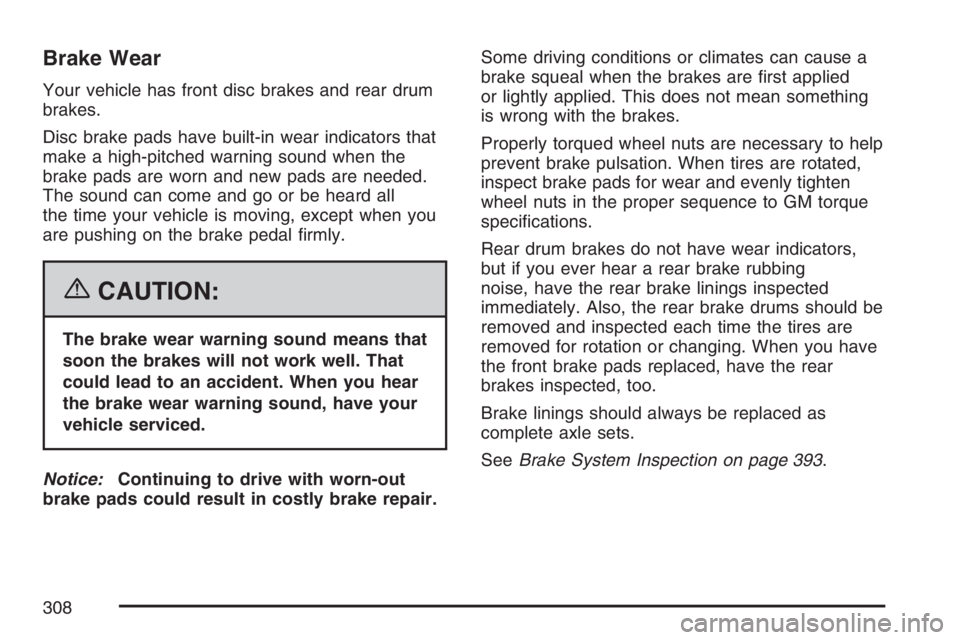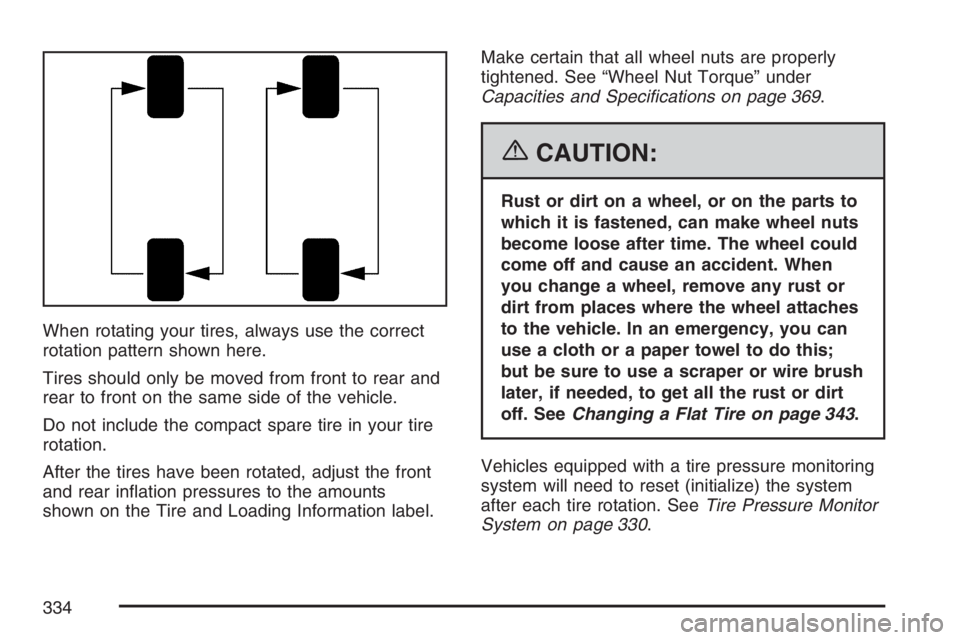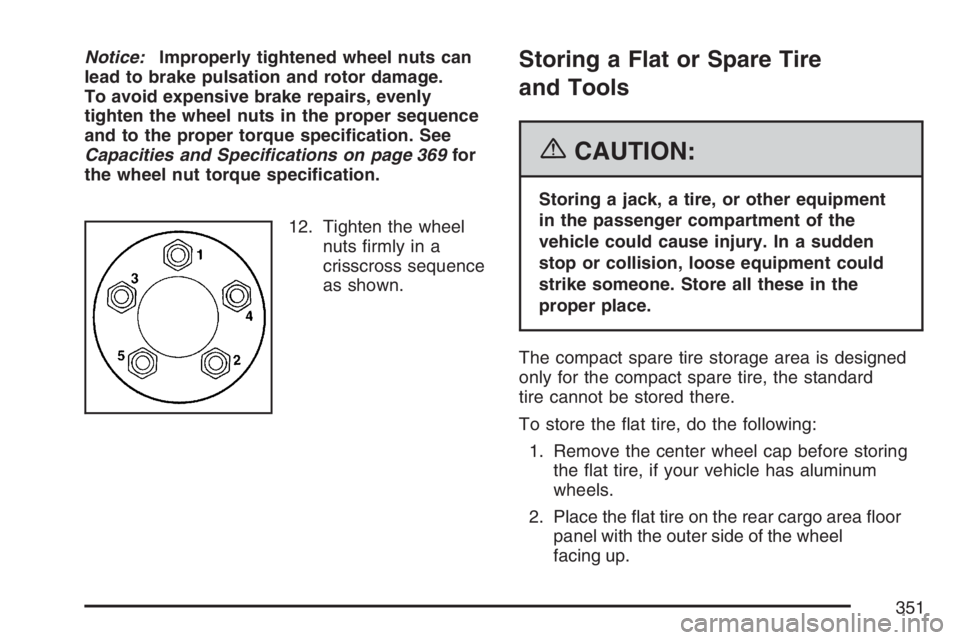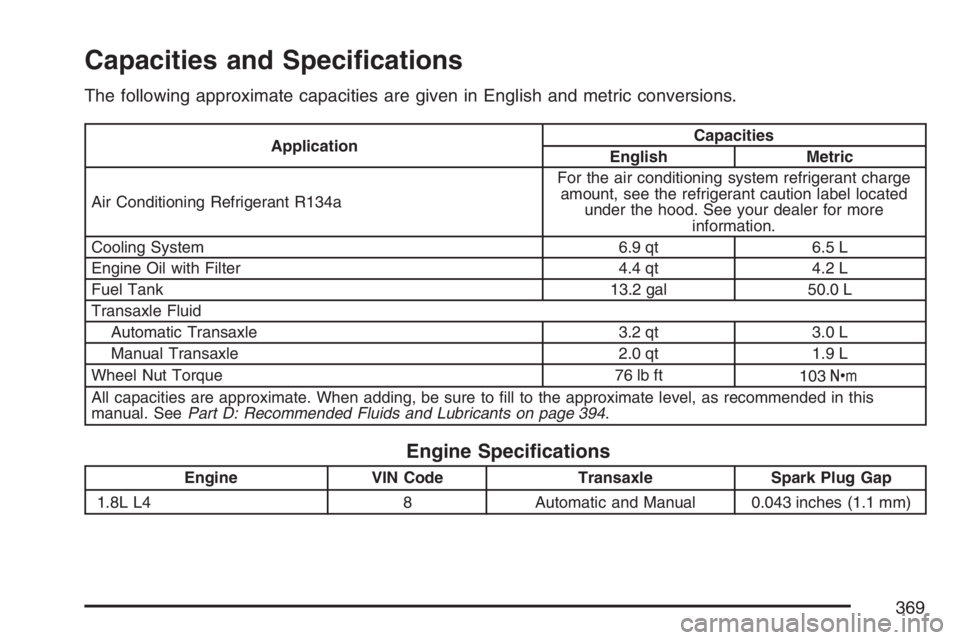wheel torque PONTIAC VIBE 2007 Owners Manual
[x] Cancel search | Manufacturer: PONTIAC, Model Year: 2007, Model line: VIBE, Model: PONTIAC VIBE 2007Pages: 432, PDF Size: 2.54 MB
Page 308 of 432

Brake Wear
Your vehicle has front disc brakes and rear drum
brakes.
Disc brake pads have built-in wear indicators that
make a high-pitched warning sound when the
brake pads are worn and new pads are needed.
The sound can come and go or be heard all
the time your vehicle is moving, except when you
are pushing on the brake pedal �rmly.
{CAUTION:
The brake wear warning sound means that
soon the brakes will not work well. That
could lead to an accident. When you hear
the brake wear warning sound, have your
vehicle serviced.
Notice:Continuing to drive with worn-out
brake pads could result in costly brake repair.Some driving conditions or climates can cause a
brake squeal when the brakes are �rst applied
or lightly applied. This does not mean something
is wrong with the brakes.
Properly torqued wheel nuts are necessary to help
prevent brake pulsation. When tires are rotated,
inspect brake pads for wear and evenly tighten
wheel nuts in the proper sequence to GM torque
speci�cations.
Rear drum brakes do not have wear indicators,
but if you ever hear a rear brake rubbing
noise, have the rear brake linings inspected
immediately. Also, the rear brake drums should be
removed and inspected each time the tires are
removed for rotation or changing. When you have
the front brake pads replaced, have the rear
brakes inspected, too.
Brake linings should always be replaced as
complete axle sets.
SeeBrake System Inspection on page 393.
308
Page 334 of 432

When rotating your tires, always use the correct
rotation pattern shown here.
Tires should only be moved from front to rear and
rear to front on the same side of the vehicle.
Do not include the compact spare tire in your tire
rotation.
After the tires have been rotated, adjust the front
and rear in�ation pressures to the amounts
shown on the Tire and Loading Information label.Make certain that all wheel nuts are properly
tightened. See “Wheel Nut Torque” under
Capacities and Speci�cations on page 369.
{CAUTION:
Rust or dirt on a wheel, or on the parts to
which it is fastened, can make wheel nuts
become loose after time. The wheel could
come off and cause an accident. When
you change a wheel, remove any rust or
dirt from places where the wheel attaches
to the vehicle. In an emergency, you can
use a cloth or a paper towel to do this;
but be sure to use a scraper or wire brush
later, if needed, to get all the rust or dirt
off. SeeChanging a Flat Tire on page 343.
Vehicles equipped with a tire pressure monitoring
system will need to reset (initialize) the system
after each tire rotation. SeeTire Pressure Monitor
System on page 330.
334
Page 350 of 432

10. Reinstall the wheel nuts with the rounded end
of the nuts toward the wheel. Tighten each nut
by hand until the wheel is held against the hub.
11. Lower the vehicle by turning the jack handle
counterclockwise. Lower the jack completely.
{CAUTION:
Incorrect wheel nuts or improperly
tightened wheel nuts can cause the wheel
to come loose and even come off. This
could lead to an accident. Be sure to use
the correct wheel nuts. If you have to
replace them, be sure to get new GM
original equipment wheel nuts. Stop
somewhere as soon as you can and have
the nuts tightened with a torque wrench to
the proper torque speci�cation. See
Capacities and Specifications on page 369
for wheel nut torque speci�cation.
350
Page 351 of 432

Notice:Improperly tightened wheel nuts can
lead to brake pulsation and rotor damage.
To avoid expensive brake repairs, evenly
tighten the wheel nuts in the proper sequence
and to the proper torque speci�cation. See
Capacities and Specifications on page 369for
the wheel nut torque speci�cation.
12. Tighten the wheel
nuts �rmly in a
crisscross sequence
as shown.Storing a Flat or Spare Tire
and Tools
{CAUTION:
Storing a jack, a tire, or other equipment
in the passenger compartment of the
vehicle could cause injury. In a sudden
stop or collision, loose equipment could
strike someone. Store all these in the
proper place.
The compact spare tire storage area is designed
only for the compact spare tire, the standard
tire cannot be stored there.
To store the �at tire, do the following:
1. Remove the center wheel cap before storing
the �at tire, if your vehicle has aluminum
wheels.
2. Place the �at tire on the rear cargo area �oor
panel with the outer side of the wheel
facing up.
351
Page 369 of 432

Capacities and Speci�cations
The following approximate capacities are given in English and metric conversions.
ApplicationCapacities
English Metric
Air Conditioning Refrigerant R134aFor the air conditioning system refrigerant charge
amount, see the refrigerant caution label located
under the hood. See your dealer for more
information.
Cooling System 6.9 qt 6.5 L
Engine Oil with Filter 4.4 qt 4.2 L
Fuel Tank 13.2 gal 50.0 L
Transaxle Fluid
Automatic Transaxle 3.2 qt 3.0 L
Manual Transaxle 2.0 qt 1.9 L
Wheel Nut Torque 76 lb ft
103Y
All capacities are approximate. When adding, be sure to �ll to the approximate level, as recommended in this
manual. SeePart D: Recommended Fluids and Lubricants on page 394.
Engine Speci�cations
Engine VIN Code Transaxle Spark Plug Gap
1.8L L4 8 Automatic and Manual 0.043 inches (1.1 mm)
369